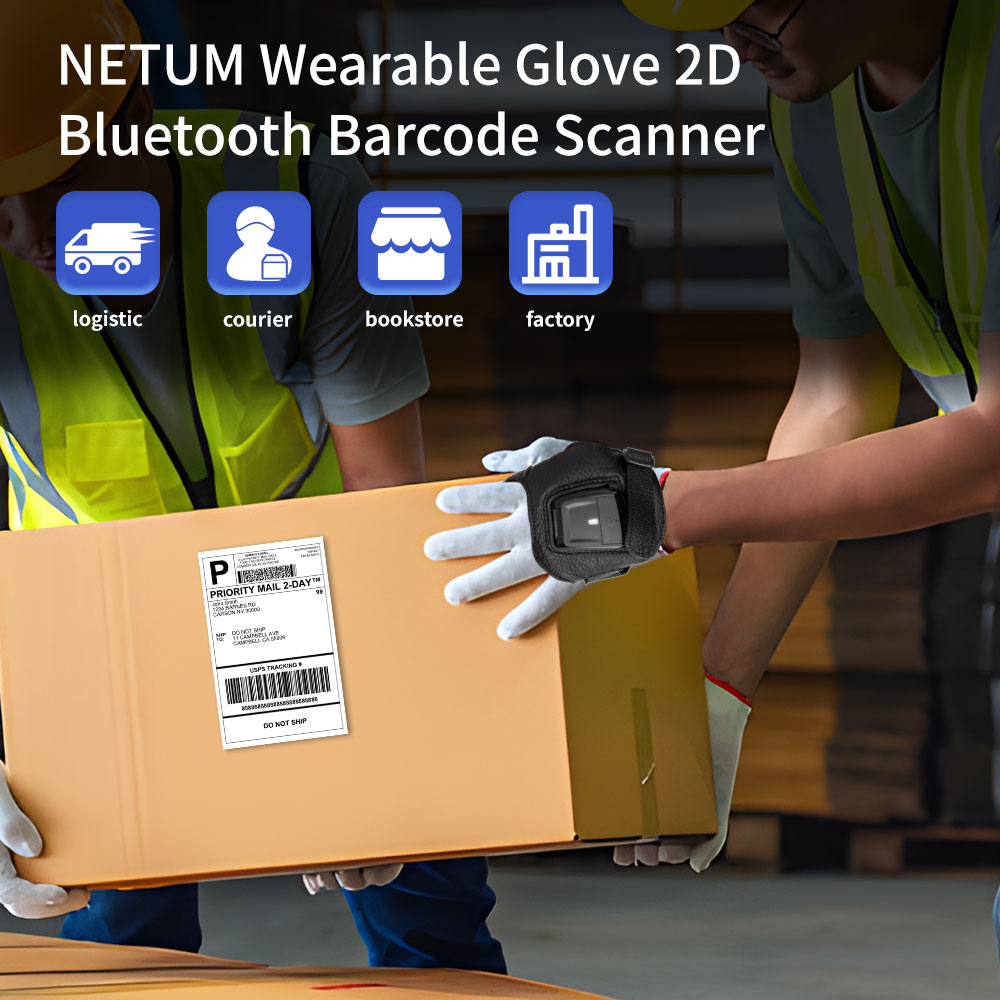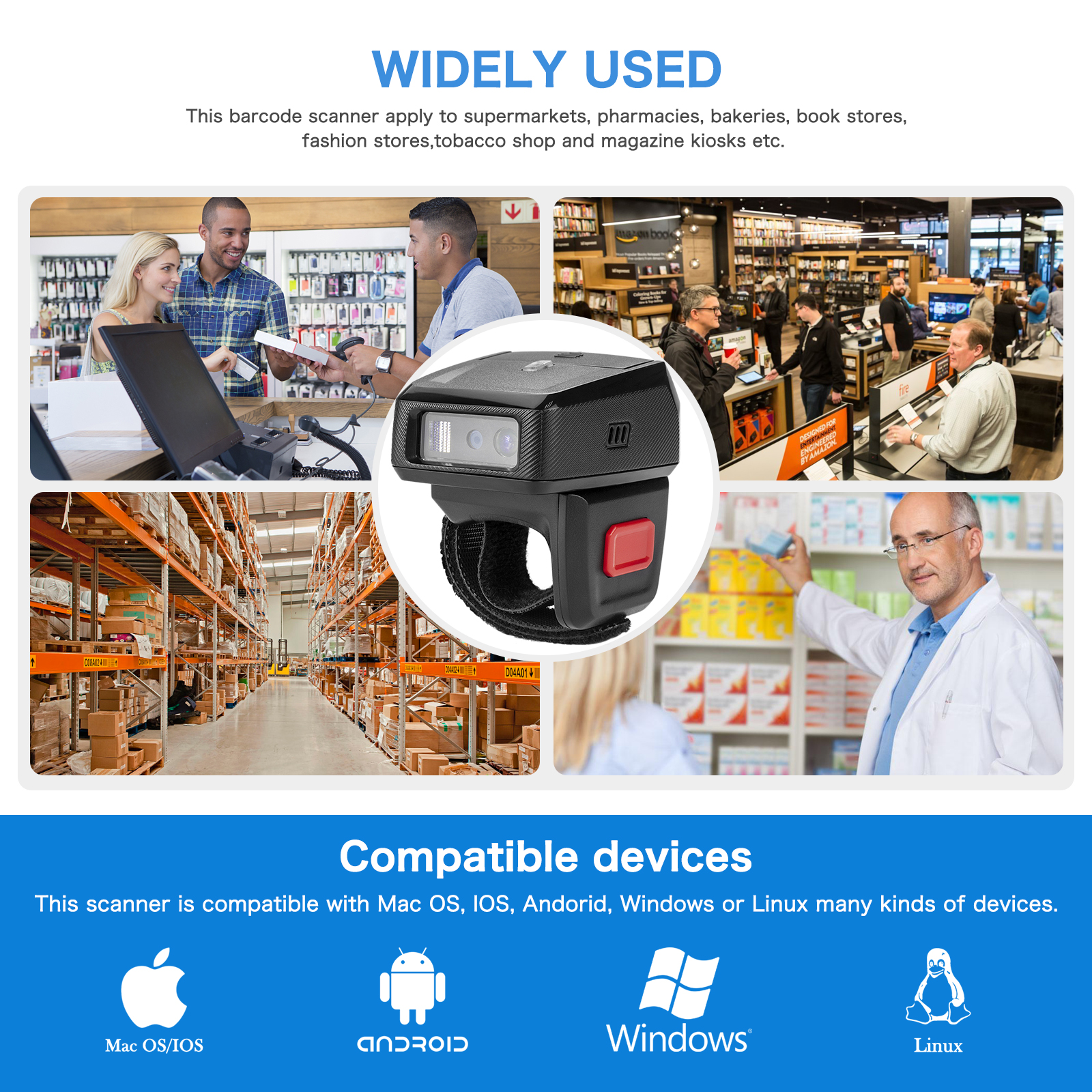A wearable barcode scanner is a smart device that revolutionizes traditional handheld scanning. Its ergonomic design and portable form factor allow users to scan barcodes without the need for a handheld device. These devices typically integrate high-precision scanning modules, wireless communication components, and long-lasting batteries, enabling rapid recognition of various 1D and 2D codes and real-time data transmission to end-user systems. Compared to traditional handheld scanners, wearable barcode scanner break the limitation of "holding the device in one hand and operating the object in the other," becoming a core tool for improving efficiency in modern logistics, retail, healthcare, and other industries.
In terms of design, wearable barcode scanners come in a variety of styles and forms. Wrist-worn devices resemble thicker smartwatches, with the scanning window cleverly embedded in the side of the strap. They typically weigh less than 50 grams, making them virtually indistinguishable from ordinary glasses when worn. Glasses-type devices feature lightweight frames with the scanning module hidden at the temple end, making them look similar to regular glasses and suitable for those who prioritize appearance. Glove-type devices integrate the scanning component into the index finger cuff, and with non-slip fabric, ensure accurate scanning even when carrying items. Ring-type devices are even more compact, with a scanning head less than 2 cm in diameter and a Bluetooth module, making them ideal for delicate tasks. These designs are all centered around "invisibility and lightweight," allowing the devices to blend seamlessly with the human body.
Wearable barcode scanners can be categorized into six main types based on how they are worn and the application scenario. Wrist-worn models are suitable for scenarios requiring frequent movement, such as retail shelf sorting and express delivery sorting. Helmet-worn models are designed for environments requiring helmets, such as warehouses and construction sites, with the scanning window aligned with the line of sight. Glasses-worn models, with their stylish appearance, are the preferred choice for healthcare and high-end retail. Ring-worn models, with their flexibility, are advantageous in jewelry appraisal and electronic component testing. Glove-worn models are targeted at situations where both hands are busy, such as logistics handling and cold storage operations. Voice-activated models, which use voice commands to control scanning, are ideal for work environments with noisy or restricted vision. A diverse range of models allows devices to precisely match the specific needs of different industries.
The core advantages of wearable barcode scanners lie in three key dimensions: efficiency, accuracy, and user experience. In terms of efficiency, the devices eliminate the need for repeated lifting and lowering, increasing scanning speeds by over 40%. In scenarios such as logistics sorting, hundreds more items can be processed daily. In terms of accuracy, autofocus and anti-shake technology reduce scanning errors by 70%, and instant feedback ensures real-time data upload. The ergonomic design significantly reduces wrist fatigue, and the lightweight and snug fit enable continuous operation for up to eight hours. Furthermore, these devices are generally waterproof, dustproof, and drop-resistant, making them suitable for use in complex environments, from cold storage to construction sites.
In practical applications, wearable barcode scanners have become a driver of efficiency across multiple industries. In logistics and warehousing, workers wearing these devices can scan while handling items, improving inventory efficiency by 50%. In healthcare, using eyewear-like devices to scan patient wristbands and medication barcodes has reduced medication errors to below 0.1%. In the retail industry, wrist-worn devices enable real-time recording of shelf replenishment, increasing out-of-stock response times by 30%. In the manufacturing industry, glove-like devices track parts on the production line, reducing quality traceability time from two hours to five minutes. These applications not only optimize workflows but also drive the in-depth development of digital transformation across industries.

With continuous technological advancements, wearable barcode scanners are becoming increasingly intelligent and integrated. The integration of voice control, RFID recognition, and biometric authentication has transformed these devices from simple scanning tools into multifunctional information terminals. The introduction of AR/VR technology enables the visual overlay of scan results. In the future, with the deepening integration of the Internet of Things and artificial intelligence, wearable barcode scanners will play an even greater role in smart factories, unmanned retail, telemedicine, and other fields, becoming a key node connecting the physical world and the digital space. Netum has been focusing on barcode scanners for 15 years and has long been committed to the field of intelligent identification applications. As a high-tech enterprise integrating R&D, production, sales, and service, its main products include barcode readers, 2D barcode scanners, scanning platforms, wearable barcode scanners, mobile handheld barcode scanners, DPM metal scanners, and industrial barcode scanners.


